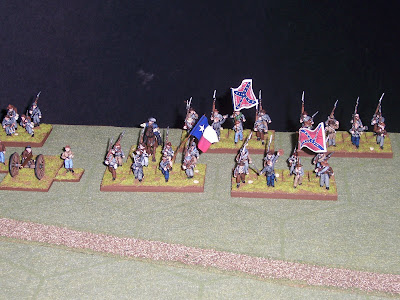
It had been a hard fight the day before, and the Union had taken a good lickin'. Two Union Corps were almost destroyed, but they doled out their share of punishment too. As Lee surveyed the field, he knew that he wanted to hit them again while the memory of their defeat was still fresh in their minds. He needed to hit them hard and drive them off those hills to his front. Once he did that, his boys would keep 'em running...crashing into the rest of the Army of the Potomac as it marched northward to reinforce them. Then it would just be a matter of pressing them...all the way to Washington; and an end to this war.

So how to hit them was the question. Lee sensed hesitation from Ewell over on the left, and A.P. Hill's Corps in the Center had done most of the hard fighting the day before and faced the strongest part of the Union line. The guns that were dug into the hill by that Cemetery would be tough to assault.

And he had found out that it was Hancock's men that had reinforced the I and IX Corps troops as they dug in last night. Those were good men, but they would run just the same if he could give them a good smash. Who would deliver the blow was obvious: It had to be Longstreet. His men were fresh and Hood's Division were the shock troops of the Army of Northern Virginia.
Where seemed pretty sure as well: The Union line was strong in the center and apparently over on the left, but to the right it seemed to just peter out at the end of the ridge as it headed over toward those two big hills on his right.
The attack would need to be made quickly so that Union reinforcements couldn't extend the line.
He gave the order for Longstreet to get his men in position and to make the attack as soon as possible. Longstreet wanted to avoid a fight here and swing around the enemy to the south, but not knowing exactly where the other Union Corps were because of his missing cavalry, Lee didn't dare to maneuver in the face of the enemy. He thought that it was much safer to smash this part of the enemy army to bits before the rest showed up. Longstreet didn't seem enthusiastic, but he was a good soldier. He would obey and drive the enemy.

As Longstreet lost several hours waiting for his Third Division, and then when ordered to move regardless, getting his men in position without being seen by the enemy, Sickles' III Corps appeared and extended the Union line southward. Now Longstreet's attack would head directly into these newly arrived troops. And when Sickles moved his forces forward to occupy the Peach Orchard, Longstreet's men were directly in his front. A collision was inevitable.

Graham's Brigade of Birney's Division occupies the Peach Orchard.

DeTrobriand's Brigade of Birney's Division occupies Rose's Woods south of the Wheat Field.

Meade's Headquarters behind Cemetery Ridge was distant enough from events on the Union Left Flank so that many decisions had to be made by the officers at hand. The battle would be won or lost on their initiative.

Longstreet's I Corp Artillery opens fire on Graham's men in the Peach Orchard to start the action at 4:00 pm on July 2, 1863.

Hood's Division was on the Confederate right flank and lead the attack. Robertson's and Anderson's Brigades...

...and Law and Benning's Brigades on their right.

At 4:00pm Longstreet gave the signal for the attack to begin.





















 Supported by part of Robertson's Brigade led by Hood himself, the Confederate attack looks like it will break the Union left and drive the enemy from the field.
Supported by part of Robertson's Brigade led by Hood himself, the Confederate attack looks like it will break the Union left and drive the enemy from the field. Sickles rides to the extreme left and orders his men to stand firm.
Sickles rides to the extreme left and orders his men to stand firm.
 Hood urges his men forward into Devil's Den and down the slope of Little Round Top to finish the Union left flank. Meanwhile the rest of Sykes V Corps arrives...
Hood urges his men forward into Devil's Den and down the slope of Little Round Top to finish the Union left flank. Meanwhile the rest of Sykes V Corps arrives...
 Semmes, Kershaw, and Anderson's Brigades move into Rose's Woods and hit De Trobriand.
Semmes, Kershaw, and Anderson's Brigades move into Rose's Woods and hit De Trobriand.
 Rose's Woods fall to the Confederate attack and the Union line recoils north of The Wheat Field.
Rose's Woods fall to the Confederate attack and the Union line recoils north of The Wheat Field.














